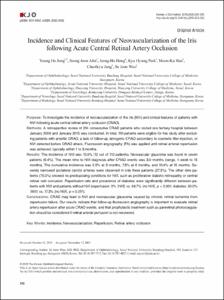Incidence and Clinical Features of Neovascularization of the Iris following Acute Central Retinal Artery Occlusion
- Keimyung Author(s)
- Hong, Jeong Ho
- Department
- Dept. of Neurology (신경과학)
- Journal Title
- Korean Journal of Ophthalmology
- Issued Date
- 2016
- Volume
- 57
- Issue
- 12
- Abstract
- Purpose: To investigate the incidence of neovascularization of the iris (NVI) and clinical features of patients with
NVI following acute central retinal artery occlusion (CRAO).
Methods: A retrospective review of 214 consecutive CRAO patients who visited one tertiary hospital between
January 2009 and January 2015 was conducted. In total, 110 patients were eligible for this study after excluding
patients with arteritic CRAO, a lack of follow-up, iatrogenic CRAO secondary to cosmetic filler injection, or
NVI detected before CRAO attack. Fluorescein angiography (FA) was applied until retinal arterial reperfusion
was achieved, typically within 1 to 3 months.
Results: The incidence of NVI was 10.9% (12 out of 110 patients). Neovascular glaucoma was found in seven
patients (6.4%). The mean time to NVI diagnosis after CRAO events was 3.0 months (range, 1 week to 15
months). The cumulative incidence was 5.5% at 3 months, 7.3% at 6 months, and 10.9% at 15 months. Severely
narrowed ipsilateral carotid arteries were observed in only three patients (27.3%). The other nine patients
(75.0%) showed no predisposing conditions for NVI, such as proliferative diabetic retinopathy or central
retinal vein occlusion. Reperfusion rate and prevalence of diabetes were significantly different between patients
with NVI and patients without NVI (reperfusion: 0% [NVI] vs. 94.7% [no NVI], p < 0.001; diabetes: 50.0%
[NVI] vs. 17.3% [no NVI], p = 0.017).
Conclusions: CRAO may lead to NVI and neovascular glaucoma caused by chronic retinal ischemia from
reperfusion failure. Our results indicate that follow-up fluorescein angiography is important to evaluate retinal
artery reperfusion after acute CRAO events, and that prophylactic treatment such as panretinal photocoagulation
should be considered if retinal arterial perfusion is not recovered.
- Keimyung Author(s)(Kor)
- 홍정호
- Publisher
- School of Medicine
- Citation
- Young Ho Jung et al. (2016). Incidence and Clinical Features of Neovascularization of the Iris following Acute Central Retinal Artery Occlusion. Korean Journal of Ophthalmology, 57(12), 352–359. doi: 10.3341/kjo.2016.30.5.352
- Type
- Article
- ISSN
- 1011-8942
- Appears in Collections:
- 1. School of Medicine (의과대학) > Dept. of Neurology (신경과학)
- 파일 목록
-
-
Download
 oak-2017-0172.pdf
기타 데이터 / 783.39 kB / Adobe PDF
oak-2017-0172.pdf
기타 데이터 / 783.39 kB / Adobe PDF
-
Items in Repository are protected by copyright, with all rights reserved, unless otherwise indicated.